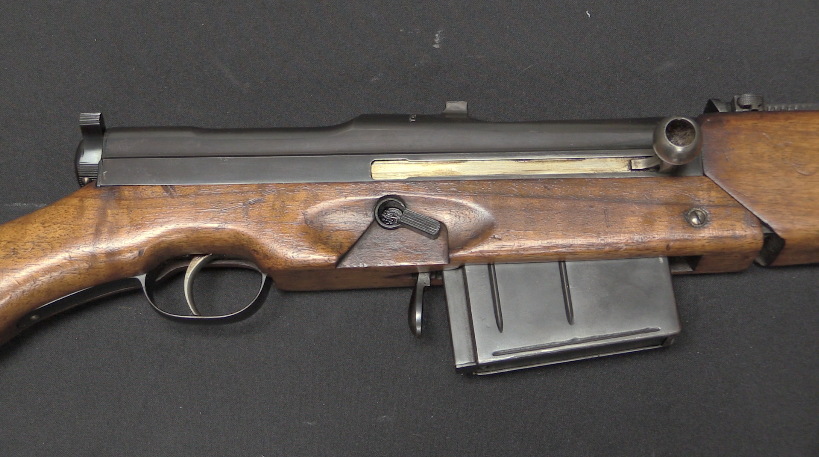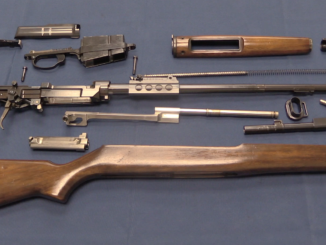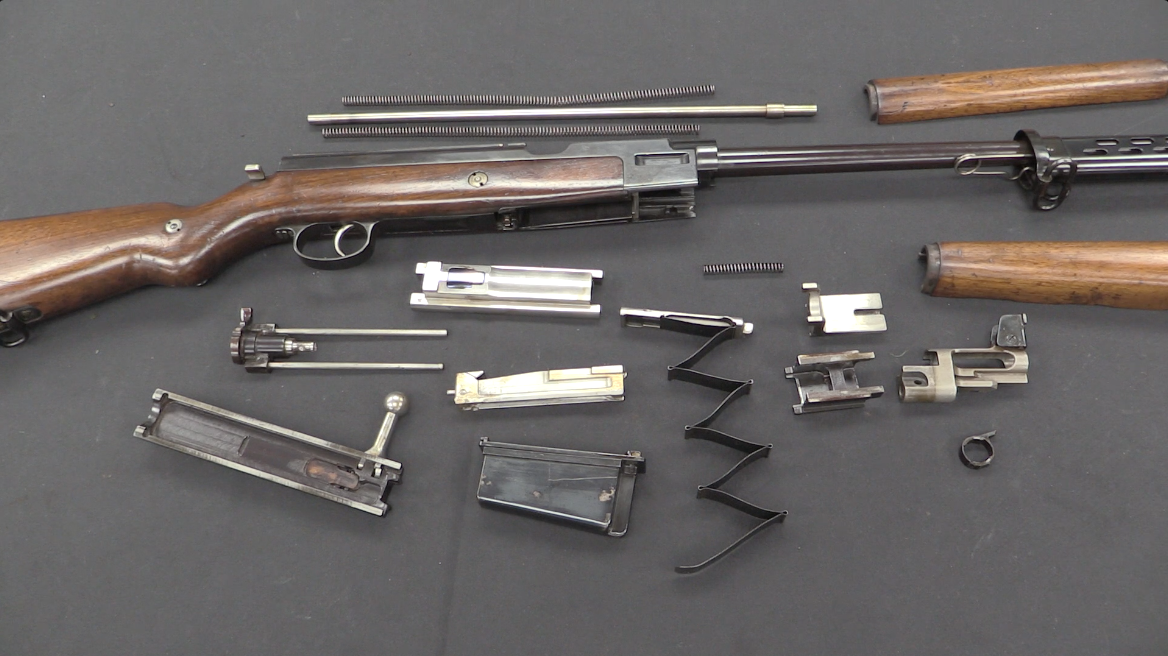The Krása project (which translates as “beauty”, but is also a shortening of “short assault rifle” – “KRÁtký SAmopal”) is a fascinating piece of Czech small arms development. In 1976, the Czechoslovakian military requested development of a compact personal weapon for special troops (paratroops, armored vehicle crews, etc) and unit commanders. It was to be chambered for the standard 7.62x39mm cartridge, but it should be no more than 1.6kg (3.5lb) empty and just 270mm (10.6″) long when folded.
The project was tackled by Jiri Čermák, who was the designed of the vz58 rifle. He began by simply shortening a vz58 as much as possible, but that was not sufficient to meet the goals. So he went on create a new rifle with a radically different feeding system. Instead of pushing rounds forward out of the magazine, it would pull them rearward, like a Mars or Boberg pistol (or like the North Korean Type 73 machine gun). This required a very different type of magazine, but allowed Čermák to create a functional weapon that was close to the requested size – 315mm (12.4″) long and 2.1kg (4.6lb).
The first prototype was designed in late 1980, and two examples were made in 1981, designated the sa81. After only a small amount of function testing, the project shifted to use the new 5.45x39mm cartridge. One example in that caliber was made, the sa83, in 1983. However, the project was cancelled at the end of 1983 in favor of the new Lada program, which planned to create a complete new family of small arms. Lada was in turn cancelled by the fall of communism, and eventually replaced by the short-lived CZ2000 family in 5.56x45mm.
The Krása project made a brief comeback around the same time as the CZ2000, called project HROM. It uses the exact same mechanism, but with distinctive elements from the Lada/2000 guns like the sights and furniture. That project also was cancelled after just a couple prototypes.
In my opinion, the reverse-feeding concept remains a fascinating potential solution for an ultra-compact PDW. Seeing someone finish its development using a cartridge like .300 Blackout today would be awesome…
Thanks to the Czech Military History Institute (VHU) for graciously giving me access to this one-of-a-kind prototype to film for you! If you have the opportunity, don’t miss seeing their museums in Prague:
https://www.vhu.cz/en/english-summary/




The design would re-emerge 40.000 years later as the Imperial bolter
LOL. Thanks for that.
“(…)should be no more than 1.6kg (…) empty and just 270mm (…) long when folded.(…)”
To put that into perspective they requested weapon as heavy as PM-63 http://modernfirearms.net/en/submachine-guns/poland-submachine-guns/pm-63-eng/ and shorter than it and firing intermediate cartridge, rather than 9×18.
We winder if that rearwards feeding mechanism was inspired by the early medium/heavy machineguns that fired rimmed cartridges from cloth belts???????
Would this really be that much better a PDW than the Skorpion?
I have to be totally honest here… I look at this thing, and the very first question that runs through my mind is “How the hell do you clear it when it inevitably jams or something misfeeds?”
The one thing I note about using a fully rebated rim cartridge with a “pull-out” style of feed is that you’d better have absolutely excellent quality control on those cartridge cases, as in “perfectly hardened” such that the mechanism doesn’t go and pull off the rim. Whether steel or brass, the whole thing is reliant on that rim remaining intact through two fairly traumatic (to the case rim…) processes: One, withdrawal from the magazine/belt, and two, the firing/ejection cycle. Your ammo isn’t spot-on perfect? You’re gonna be hating life. I sat next to a guy who was firing some seriously sub-par ammo through his Browning .30 caliber MG, once upon a time, and between the corrosion on the cases and the metallic belt, plus the cases themselves being either out-of-spec or the years they were in storage doing them damage, that gun jammed heinously. I remember one firing cycle where the extractor tore the base off the round that just fired, and the feed claws tore through the rim on the cartridge that was next in line… Ugly.
Looking at the feed path on this thing? I’m gonna go out on a limb and hazard a guess that either the Czechs were gonna have to up their game in terms of cartridge quality, or the guns were going to be incessant jam-o-matics.
Sometimes, simplicity really is better.
This was the bugaboo of every belt-fed HMG chambered for a rimmed cartridge, from 0.303in to 7.62x54R and so on. By the nature of their cartridge design, the feed system had to pull the cartridge backward out of the belt first, then ram it forward into the chamber.
Quite aside from the problems with long-term stored belted ammunition, there was the issue of the rounds “debulleting” when subjected to this level of abuse. There’s a reason for the heavy crimp on British 0.303in MK 8Z Ball for the Vickers-Maxim, and this was it.
Let’s not even go into the issues of the mechanism required for a feed geometry that requires the round to be first pulled backward out of the belt and then shifted vertically to go over or under it to get to the chamber. A box-magazine fed design, like this, really only has the “over” option, as on the Gabbett-Fairfax Mars pistol.
On a side note there, Hugh Gabbett-Fairfax had some interesting ideas regarding high-velocity cartridges, but he probably should have let somebody else design the platforms to launch them from.
In short, instead of trying to design high rate-of-fire feed mechanisms around rimmed cartridges, start by designing a proper rimless cartridge. This allows you to avoid putting each cartridge through unnecessary gymnastics to get it into the chamber.
If you are in fact starting with an accepted rimless cartridge and indulge in such contortions anyway, you’re probably doing it wrong.
clear ether
eon
“(…)nature of their cartridge design, the feed system had to pull the cartridge backward(…)”
Not true. RACHOT http://modernfirearms.net/en/machineguns/czech-republic-machineguns/vz-59-uk-vz-59-eng/ did both use rimmed cartridge AND feed straight forward from the belt pocket and into the chamber
PK’s competitor, Nikitin’s PN also had straight feed. In both cases IIRC bolt pushed round down and forward, freeing it from the open pocket belt.
“(…)Czechs were gonna have to up their game in terms of cartridge quality(…)”
But… that would not help with cartridges made by other WarPact members.
Whole point of common ammunition is missing if it could not freely interchanged.
PKM works with same type of claw cartridge puller that first snaps over rim and then pulls it out of belt. My experience with Yugo M84 version was that I have never seen torn rim on the local ammo with brass cases. I have heard that with steel cased ammo (of unknown origin) it happened occasionally, through not when pulling it out of belt but during regular extraction if chamber was extremely dirty.
For a MG pull-push is fundamentally better system than direct feed, it enables to pull cartridge out of belt when bolt/BC are at the peak energy level, belt is also pulled at the same time. This dumps energy, and felt recoil from a bolt carrier hitting a buffer is additionally lowered. In contrast, with MG34/42 derived direct feed, there is no energy dumping, so bolt will hit buffer at higher velocity, all other things being equal. Additionally, removal of the cartridge from belt is done with the strength of the return spring only, on the return stroke. Even worse belt is also moved on return stroke, which is why MG34/42 derived feeds often have problems with hanging belts, while PKM will pull basically any length of the free hanging belt (seen it with 250 rounds belt hanging in the air, gun did not care, pulled it w/o problem).
Pull-push has additional benefit that it does not care about belt being upside-down, nice bonus under stress (In Ian’s M84/PKM video belt is formally upside down… did not matter).
It is a prime example of the weird category of engineering where simpler (direct feed) is not always better.
Kalashnikov successfully converted a liability in an advantage, but the MG42 is a poor comparison recoil wise, since it has a recoil booster, that obviously boosts recoil.
The energy required to push the cartriges out of the belt is not really different to the one required to push them out of a magazine. Hardly a nuisance.
Also the MG42, and derivates, pulls the belt both in opening and in closing. It would have not been a problem to design a system that pull the belt only in opening, but the designers preferred a smoother operation, also due to the very high ROF.
The M60 pulled the belt only in opening, and it jammed with extreme ease. Not because it lacked energy to pull it, but because it lacked an effective system to retain the belt under tension.
If you think of it, pulling a bottle neck cartridge out of a belt is much simpler than trying to push it forward. it’s not like the pulling claw is rocket science.
Again, only so long as you can maintain quality control on your ammunition production lines.
If you can, so be it. If not? Then you had best design your weapons so as to compensate for lousy QC.
The issue is holistic; you have to be able to maintain a sense of realism when it comes to all of this. If your industrial processes are up to snuff, then you can get away with all sorts of design issues. If not? You’re going to lose on the basis if “I can’t make enough good ammunition, repeatedly and at scale”.
Not really. Infact no MG native in a rimless cartridge in the metallic belts era extracts it backward.
to extract a cartridge backward you need a couple of elastic hooks that snap over the rim, ot a rigid structure that slides over it (both requires high precision), then a system to put the cartridge at the same level of the barrel.
To extract it forward, you only ned an open pocket belt, a part of the bolt that interferes with a part of the case back and a ramp. To obtain the same reliability, you need less parts and less precision.
Again, and with all respect, I think that the Darne–albeit using a cloth belt I think–used a rimless cartridge, but pulled it out of the belt, before then ramming it up over the belt into the chamber. Maybe not much of a qualification, but on the verge of the metallic belts era, no?
Maxims began in the rim and cloth era, but they push-pulled many rimless cartridges from metal belts just fine. BMGs are as ‘native rimless’ as it gets.
Every ‘rimless’ cartridge has a rim. The claw or extractor groove doesn’t care whether its flush or protruding.
“(…)Darne–albeit using a cloth belt I think–used a rimless cartridge(…)”
Some of them did, but some consumed rimmed ·303 British cartridge, see 2nd image from top https://www.warhistoryonline.com/guns/darne-machine-gun.html
@ Dave
Cartridges can only be extracted backward from cloth belts. It’s not a choice.
Infact i stated above “no MG native in a rimless cartridge in the metallic belts era extracts it backward” and “need an open pocket belt”.
The Darne was designed during WWI in 8mm Lebel, a rimmed cartridge, then adapted to .303 British, another rimmed cartridge, and the ability to use cloth belts in storage from WWI was considered a plus.
The versions made for rimless cartridges were later modifications.
Maxim too early to be ‘native’ to metal belts, but pulled lots of ‘rimless’ ctgs out of them. BMG, ‘native’ as can be.
@ JMB
Again. Cartridges can only be extracted backward from cloth belts. It’s not a choice.
When they have the choice, because you can extract a cartridge from a metallic belt both ways, designers don’t design MGs to extract rimless cartridges backward.
@ JMB
And, to be clear, it’s not because there is a technical reason why rimless cartridges can’t be pulled backward. Its’ OBVIOUS they can. We all know here they have a rim and how extractors work.
It’s because THEY ARE NOT OBLIGED TO DO SO, and push them forward is EASIER.
Honestly, this thing–if Krasa means “beauty” in Czech or Slovak…eesh–gives me serious Darne machine gun vibes. Of all the cartridge-extracted-from-feed-device-first, then pushed-into-chamber firearms, this is the one I thought it most closely resembled.
The ueber-commie lavish use of spot welds and secret peoples-scientist contrived materials like “Pertinax” is noted.
This looks to me as a Czechoslovak entrant into the AKS74U design sweepstakes, albeit hindered by lack of access to the then newfangled 5.45x39mm cartridge. The Peter Andreyevich Tkachev prototype–AO46?–used the box magazine as the actual firing grip, putting it in the same spot as the samopal VZ23/25 & 24/26, the Uzi 9mm, or, for that matter, most like the Italian O.G. 43 where the magazine is not inside the pistol grip, but actually forms the pistol grip.
Interesting that Jiri Čermák eschewed bull-pul layout all together in an effort to make things more compact. In this specific design criteria, I’d be hard pressed to do so, given that whatever the faults or compromises of bullpup firearm designs, compromising barrel length is not one of them… I mean, if the AMD-65 is excruciatingly short with 7.62x39mm, I cannot imagine a 5-1/2-in. long barrel! Just crazy.
For a 7.62x39mm cal. PDW, I’d be inclined to re-examine the “Soviet space magic” TKB-022 or TKB-011.
Due to outward appearances, I’m wondering if there is some kind of design continuity between this blaster and the prototype “PDW” CZW 438, that used some sort of 4.38x30mm/ “.17 Libra” cartridge in the “improved penetration” criteria currently in vogue due to body armor and so on? Perhaps a Czech or Slovak expert might weigh in to discuss whether there was some kind of connection… Or maybe a forthcoming Mr. M’Collum episode from Prague is nigh?
I’m waiting for the CZ514/522 and most especially for the ZB530 prototype with its top feed magazine and so on. Kind of a a service-rifle sized ZB26/30…
Czechs are straight from Mars.
They are really, really unusual, in the Slavic World.
They are “interesting” as tourists during sea vacations; they like to put themselves in most perilous positions (like swimming to the open sea with inflatable unicorn or hiking on a karst mountain with flip flops), waaaay more often than other tourists groups/nations.
We joked cynically is that maybe a manifestation of their freed spirit, after being enslaved in czechoslovakia by eastern block for so long ?
Last sad incident this summer was where czechs entered and sweeped military range looking for interesting goodies and artifacts, and found unexploded iirc 40mm grenade, took it in their car and continued to drive along, supposedly going back to homecountry. Unfortunately something happened when they stopped some time afterwards as a primary school kid was playing with it, it exploded and killed him and wounded the others.
Indipendently from the pulling “claws”, that come straight from the PK, but are not essential to the system, I really like the “rising bolt” locking.
It seems a modernization of the Breda rising bolt system (see the Breda PG, or the Breda 37 HMG) that I always considered an interesting alternative to the AK/AR bolt, to have frontal locking lugs without a rotating bolt.
Also the double-use hammer/lifter is very clever.
I toyed with similar ideas when I was tinking of an “alternative NGSW”, since the back-pulling cartriges allow to have a 2-3 inches longer barrel without a bullpup configuration.
A problem is that it makes the lock open on the last round useless, since you have to pull the bolt back anyway to load the first round.
Functions very much like an old Stevens Visible-Loader model 70…
In the Visible-Loader, they were trying to utilize single shot frames into being a pump-action, tube-fed repeater rifle. The rounds and carrier move backwards outside of the receiver with each pump, versus the enclosed receiver of this rifle. There is even an inclined surface to direct the round from the “pull” position to the “push” position, though the use of the hammer in the sa81 is brilliant! The magazine feed presents the rounds in the same position as a tube-fed longarm would.
If we could get some company to produce this in .300blk, it would be pretty useful and handy.
“(…)Visible(…)”
Now when you mentioned if, that reminded me about Krag-Peterson https://www.militaryrifles.com/m1876kragpetersson